Here’s another guide to some of my favorite post-apocalyptic literature. I call these books classics, not necessarily because they’ve been embraced by the literature world like normal classics, but because they’re old. Their age gives them a staggering and lasting effect that makes the authors seem almost prophetic in nature. Many of the fears, themes and generalizations are nearly predictive in nature and have many striking similarities in today’s world and current post-apocalyptic literature.
Top 6 classic post-apocalyptic novels for the modern reader. Share on XEarth Abides: George R. Stewart (1949)
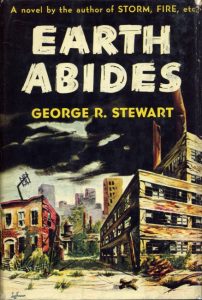
Earth Abides by George R. Stewart is the literal definition of a classic, at least when it comes to the post-apocalyptic genre. Earth Abides has been published in over 20 different languages and has not been out of print since publication in 1949. The book takes place in three parts, “World Without End”, “The Year 22”, and “The Last American”. The beginning of this book is one of my all-time favorites. Our main character, Isherwood Williams is living alone in the woods and recovering from a sickness with the symptoms of measles. As he reenters society he notices the world is nearly empty and that most people have died from the same sickness he recovered from. There’s an eerie chill about the way Stewart describes the breakdown of society and the remnants of what’s left behind. It’s a long book that includes cross-country trips across a barren United States, the building of a new family, the recreation of a civil society, the eventual rise of a younger generation and the degradation of human life back to a primitive existence. One of the best aspects of this book, in my opinion, is the way Stewart predicts the way nature takes over the planet in waves of plant overgrowth, rats, cattle, mountain lions, and more. This book is a must for anyone looking for a timeless post-apocalyptic story that is still hauntingly relevant nearly 70 years after publication.
Alas, Babylon: Pat Frank (1959)
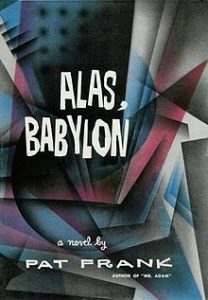 Alas, Babylon takes place in the fictional town of Fort Repose, Florida after a devastating nuclear event. Our main character is Randy Bragg and he is the apocalypses’ first cheater. Randy has the benefit of having a brother in Air Force intelligence who tips him off of the impending nuclear strike. An Air Force incident in Eastern Europe causes a fighter jet to accidentally release an American sidewinder missile attack on Latvia. In turn the Soviet Union launches a multi-faceted nuclear attack on the United States that nearly brings the country to its end. Chaos ensues; bank runs, food shortages, prisoner escapes, banditry and the spread of radioactive goods out of the radiation zones. Bragg, a former Army officer, takes charge of organizing his neighbors and the town in their survival efforts while the nation begins to rebuild and survive as barely a skeleton of the United States is all that remains.
Alas, Babylon takes place in the fictional town of Fort Repose, Florida after a devastating nuclear event. Our main character is Randy Bragg and he is the apocalypses’ first cheater. Randy has the benefit of having a brother in Air Force intelligence who tips him off of the impending nuclear strike. An Air Force incident in Eastern Europe causes a fighter jet to accidentally release an American sidewinder missile attack on Latvia. In turn the Soviet Union launches a multi-faceted nuclear attack on the United States that nearly brings the country to its end. Chaos ensues; bank runs, food shortages, prisoner escapes, banditry and the spread of radioactive goods out of the radiation zones. Bragg, a former Army officer, takes charge of organizing his neighbors and the town in their survival efforts while the nation begins to rebuild and survive as barely a skeleton of the United States is all that remains.
The Handmaid’s Tale: Margaret Atwood (1985)
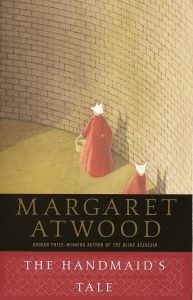 The Handmaid’s Tale is currently receiving more attention than ever in it’s 32-year-old history, due to an extremely popular and relevant mini-series on Hulu. The Handmaid’s Tale takes place in the near future in a totalitarian theocracy named the Republic of Gilead. The Republic of Gilead is a Christian based society in the former United States territory, which is plagued by ecological wastelands, where women have no rights of property, travel, and in some cases even their own bodies. Gilead is basically a society of modern day Puritans who completed a rebellion against the United States following a staged terrorist attack on the President’s life. In this period of time birth rates are declining due to sterility caused by sexually transmitted diseases and pollution. The main character is an unnamed woman who is called “Offred” because her “commander’s” name is Fred, hence Of-Fred. “Commander” you ask? Offred is a “Handmaid” who is responsible for helping her Commander and his wife create a child. Offred and the other handmaids frequently are forced into the “ceremony” with their commanders who try to impregnate them to act as surrogates due to almost no couples being unable to conceive. Offred weaves her way through this new world with many thoughts of her old life, previous handmaids, her friends and the things she left behind. While trying to survive her way through her fellow handmaids, her commander, the commanders wife, Mayday spies, and trying to avoid being sent to the colonies full of ecological waste and disease. Margaret Atwood is a truly great post-apocalyptic/dystopian author who has written quite a few great titles in the genre and this classic is sure to please. Many writers and fans see parallels between the novel/television series and the current political climate in the United States following last November’s election.
The Handmaid’s Tale is currently receiving more attention than ever in it’s 32-year-old history, due to an extremely popular and relevant mini-series on Hulu. The Handmaid’s Tale takes place in the near future in a totalitarian theocracy named the Republic of Gilead. The Republic of Gilead is a Christian based society in the former United States territory, which is plagued by ecological wastelands, where women have no rights of property, travel, and in some cases even their own bodies. Gilead is basically a society of modern day Puritans who completed a rebellion against the United States following a staged terrorist attack on the President’s life. In this period of time birth rates are declining due to sterility caused by sexually transmitted diseases and pollution. The main character is an unnamed woman who is called “Offred” because her “commander’s” name is Fred, hence Of-Fred. “Commander” you ask? Offred is a “Handmaid” who is responsible for helping her Commander and his wife create a child. Offred and the other handmaids frequently are forced into the “ceremony” with their commanders who try to impregnate them to act as surrogates due to almost no couples being unable to conceive. Offred weaves her way through this new world with many thoughts of her old life, previous handmaids, her friends and the things she left behind. While trying to survive her way through her fellow handmaids, her commander, the commanders wife, Mayday spies, and trying to avoid being sent to the colonies full of ecological waste and disease. Margaret Atwood is a truly great post-apocalyptic/dystopian author who has written quite a few great titles in the genre and this classic is sure to please. Many writers and fans see parallels between the novel/television series and the current political climate in the United States following last November’s election.
I Am Legend: Richard Matheson (1954)
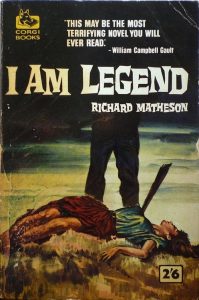 I am Legend has been sited as an early inspiration to the vampire/zombie genre as well as the concept of worldwide apocalypse due to disease outbreak. The story takes place in Los Angeles and follows Doctor Robert Neville who is seemingly the lone survivor of a disease that’s symptoms resemble vampirism. Neville, a raging alcoholic, spends his days studying, killing the “vampires” and trying to cure the disease. He spends his nights boarded up inside of his home protected by typical vampire repellent methods while they continuously bombard his residence trying to gain entry. Neville eventually meets a woman who is not quite who he thinks she is, once his world is turned upside down he learns that what he thinks is right isn’t necessarily what will save humanity. Being one of the main inspirations for Night of the Living Dead should tell you a whole lot about I Am Legend and it’s status as one of the great classics of the genre. The 2007 hit film based on the novel starring Will Smith as well as the 1971 Charlton Heston adaptation called Omega Man are both worth checking out if you enjoy Neville’s adventures.
I am Legend has been sited as an early inspiration to the vampire/zombie genre as well as the concept of worldwide apocalypse due to disease outbreak. The story takes place in Los Angeles and follows Doctor Robert Neville who is seemingly the lone survivor of a disease that’s symptoms resemble vampirism. Neville, a raging alcoholic, spends his days studying, killing the “vampires” and trying to cure the disease. He spends his nights boarded up inside of his home protected by typical vampire repellent methods while they continuously bombard his residence trying to gain entry. Neville eventually meets a woman who is not quite who he thinks she is, once his world is turned upside down he learns that what he thinks is right isn’t necessarily what will save humanity. Being one of the main inspirations for Night of the Living Dead should tell you a whole lot about I Am Legend and it’s status as one of the great classics of the genre. The 2007 hit film based on the novel starring Will Smith as well as the 1971 Charlton Heston adaptation called Omega Man are both worth checking out if you enjoy Neville’s adventures.
Lucifer’s Hammer: Larry Niven and Jerry Pournelle (1977)
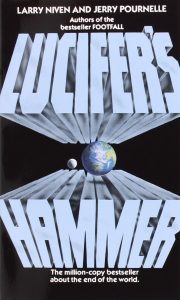 The Hammer is a comet that collides with earth, the novel Lucifer’s Hammer is about those who survived the cataclysmic event and it’s after effects. Pieces of the comet impact many parts of the planet and cause volcanic eruptions, earthquakes, floods, and non-stop rain around the globe. The comets effects on our story revolve around it’s impact on California and the devastation that ensued. Our main characters, of which there are many, end up in new survivor communities where people are forced to work in near serfdom and protect themselves from warring gangs of bikers, survivalists and form newfound legions. Society goes through a massive change where lawyers, executives, police and professionals are obsolete and farmers, thugs and blue collar workers are on the top of the food chain. Tribalism breaks out and the novel follows the attempts of the different groups to take over one another and remains as the last standing group to rebuild life in the Sierra Nevada region of California. One of the things that make Lucifer’s Hammer such a classic is the solid science the author employs. The accuracy of the science involving the comet and it’s impacts on the world are frighteningly real and would put fear into the average reader. If you enjoy typical themes of most post-apocalyptic writing then you’ll find enjoyment in Lucifer’s Hammer.
The Hammer is a comet that collides with earth, the novel Lucifer’s Hammer is about those who survived the cataclysmic event and it’s after effects. Pieces of the comet impact many parts of the planet and cause volcanic eruptions, earthquakes, floods, and non-stop rain around the globe. The comets effects on our story revolve around it’s impact on California and the devastation that ensued. Our main characters, of which there are many, end up in new survivor communities where people are forced to work in near serfdom and protect themselves from warring gangs of bikers, survivalists and form newfound legions. Society goes through a massive change where lawyers, executives, police and professionals are obsolete and farmers, thugs and blue collar workers are on the top of the food chain. Tribalism breaks out and the novel follows the attempts of the different groups to take over one another and remains as the last standing group to rebuild life in the Sierra Nevada region of California. One of the things that make Lucifer’s Hammer such a classic is the solid science the author employs. The accuracy of the science involving the comet and it’s impacts on the world are frighteningly real and would put fear into the average reader. If you enjoy typical themes of most post-apocalyptic writing then you’ll find enjoyment in Lucifer’s Hammer.
The Stand: Stephen King (1978)
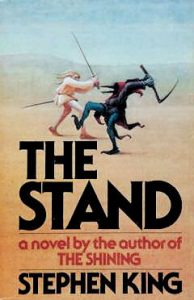 Last but not least The Stand is one of the most critically acclaimed post-apocalyptic classics ever published. Inspired by Earth Abides, The Stand is based on the outbreak of a strain of the flu that had been weaponized by the US Army for biological warfare. When the influencza was accidentally released from a security bunker, civilization is decimated and human kind is facing extinction with nearly everyone on the planet dead. One of the main themes of The Stand is the breakdown and destruction of society through violence and barbaric human behaviors as well as the fight between good and evil. Like Earth Abides, The Stand, takes place in three parts “Captain Trips”, “On the Border” and “The Stand”. As the stories survivors begin varying odysseys across the country they are drawn together by supernatural events. The book takes a turn towards the supernatural when “Mother Abigail” (good) draws people towards Colorado to begin living in the “free-zone” meanwhile the (evil) Randal Flagg attracts others who are drawn by destruction, devastation and chaos towards Las Vegas to create a civilization that will become the dominant society . The rest of the novel follows developments of the different factions and confrontations between the two. The Stand is one of King’s greatest accomplishments, I’m usually not one for the supernatural but it works in this storyline. The Stand was an instant classic, if you enjoy the novel check out the made for TV mini-series and keep your eyes out for the modern day remake.
Last but not least The Stand is one of the most critically acclaimed post-apocalyptic classics ever published. Inspired by Earth Abides, The Stand is based on the outbreak of a strain of the flu that had been weaponized by the US Army for biological warfare. When the influencza was accidentally released from a security bunker, civilization is decimated and human kind is facing extinction with nearly everyone on the planet dead. One of the main themes of The Stand is the breakdown and destruction of society through violence and barbaric human behaviors as well as the fight between good and evil. Like Earth Abides, The Stand, takes place in three parts “Captain Trips”, “On the Border” and “The Stand”. As the stories survivors begin varying odysseys across the country they are drawn together by supernatural events. The book takes a turn towards the supernatural when “Mother Abigail” (good) draws people towards Colorado to begin living in the “free-zone” meanwhile the (evil) Randal Flagg attracts others who are drawn by destruction, devastation and chaos towards Las Vegas to create a civilization that will become the dominant society . The rest of the novel follows developments of the different factions and confrontations between the two. The Stand is one of King’s greatest accomplishments, I’m usually not one for the supernatural but it works in this storyline. The Stand was an instant classic, if you enjoy the novel check out the made for TV mini-series and keep your eyes out for the modern day remake.

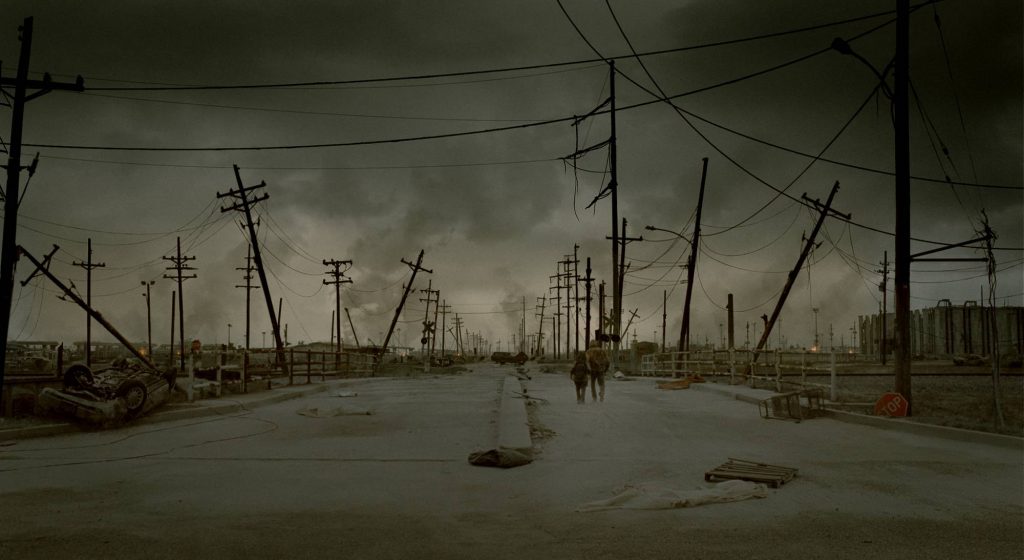
I am Legend was first filmed in 1964 as “The Last Man on Earth” and starred Vincent Price. It was the version that most closely resembled the book thus far.